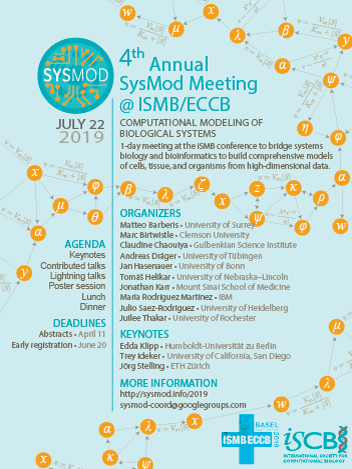Overview
Advances in genomics are creating new opportunities to understand biology that require both systems modeling and bioinformatics. The fourth annual SysMod meeting will be a forum for discussion about combined use of systems biology modeling and bioinformatics to understand biology and disease. The meeting will take place July 22, 2019 during the 2019 ISMB/ECCB conference in Basel. The meeting will feature several keynote talks and contributed presentations.
Topics
Methods
Dynamical modeling
Flux balance analysis
Logical modeling
Network modeling
Stochastic simulation
…
Systems
Animals
Bacteria
Humans
Plants
Yeast
…
Applications
Bioengineering
Cancer
Developmental biology
Immunology
Precision medicine
…
Schedule
| 8:30-9:30 | ISMB keynote talk |
|---|---|
| 9:30-10:00 | Coffee break with exhibitors |
| 10:15-12:40 | Session I: Systems biology of human cells and diseases Moderator: Julio Saez-Rodriguez, Systems Biomedicine, BioQuant, Heidelberg University, DE |
| 10:15-10:20 | Introduction to SysMod 2019 Andreas Dräger Insititute for Biomedial Informatics (IBMI), University of Tübingen, DE
The community of special interest (COSI) in systems modeling (SysMod) organizes annual one-day gatherings. In 2019 the meeting comprises three sessions that cover a broad variety of topics, beginning with human cells and disease modeling, followed by the afternoon session on the systems biology of microorganisms and concludes with current trends in the field. Each of the three sessions features one of the keynote speakers, Douglas Lauffenburger, Edda Klipp, and Jörg Stelling. The event is hosted by Claudine Chaouiya, María Rodriguez Martinez, and Andreas Dräger on behalf of the ten COSI organizers. This brief talk introduces all speakers, organizers, and main topics of the 2019 meeting. |
| 10:20-11:00 | Interpreting the cancer genome through physical and functional models of the cancer cell Trey Ideker University of California, San Diego, US Recently we and other laboratories have launched the Cancer Cell Map Initiative (ccmi.org) and have been building momentum. The goal of the CCMI is to produce a complete map of the gene and protein wiring diagram of a cancer cell. We and others believe this map, currently missing, will be a critical component of any future system to decode a patient’s cancer genome. I will describe efforts along several lines: 1. Coalition building. We have made notable progress in building a coalition of institutions to generate the data, as well as to develop the computational methodology required to build and use the maps. 2. Development of technology for mapping gene-gene interactions rapidly using the CRISPR system. 3. Causal network maps connecting DNA mutations (somatic and germline, coding and noncoding) to the cancer events they induce downstream. 4. Development of software and database technology to visualize and store cancer cell maps. 5. A machine learning system for integrating the above data to create multi-scale models of cancer cells. In a recent paper by Ma et al., we have shown how a hierarchical map of cell structure can be embedded with a deep neural network, so that the model is able to accurately simulate the effect of mutations in genotype on the cellular phenotype. |
| 11:00-11:20 | Personalization of logical models using multi-omics data and its use in the study of clinical stratification and drug response Jonas Béal, Arnau Montagud, Emmanuel Barillot, and Laurence Calzone Institut Curie, FR
Mathematical models of cancer pathways are built by mining the literature for relevant experimental observations or extracting information from pathway databases. As a consequence, these models generally do not capture the heterogeneity of tumors and their therapeutic responses. We present here a novel framework, PROFILE, to tailor logical models to particular biological samples such as patient tumors, compare the model simulations to individual clinical data and investigate therapeutic strategies.Our approach makes use of MaBoSS, a tool based on Monte-Carlo kinetic algorithm to perform stochastic simulations on logical models resulting in model state probabilities. This semi-quantitative framework allows to integrate mutation data, copy number alterations (CNA), and transcriptomics/proteomics into logical models. These personalized models are validated by comparing simulation outputs with patients’ clinical data (subtypes, survival) and then used for cell line-specific investigations regarding the effects of drug perturbations, allowing both verification of the theoretical behavior of the model and comparison with experimental drug sensitivities.Our approach aims to combine the mechanistic insights of logical modeling with multi-omics data integration to provide patient or cell line-relevant models that can serve as tools for analyzing therapeutic responses. |
| 11:20-11:40 | Making Sense of Large Kinetic Models Fabian Fröhlich, Luca Gerosa, and Peter Sorger Harvard University, US
In recent years, simulation and training of large kinetic multi-pathway models with hundreds to thousands of species and parameters has become increasingly tractable. These large kinetics models are often constructed with the aim to deepen our mechanistic understanding of signaling pathways. Yet, the high complexity of large kinetic models impedes our ability to understand signal transduction in the model and thus limits possibilities for mechanistic insight and hypothesis generation.Here we propose the use of model structure to provide high- and low-level descriptions of signaling dynamics. We exploit the abstraction of rule-based models to provide protein-level summaries of signaling dynamics. To study emergent properties of the model, we apply a combination of causal compression and hierarchical modularization to provide pathway-level summaries of signal transduction.We apply these methods to an ordinary differential equation model of adaptive resistance in melanoma (EGFR and ERK pathways, >1k state variables, >10k reactions). We trained the model on absolute proteomic and phospho-proteomic as well as time-resolved immunofluorescence data, both in dose-response to small molecule inhibitors. We illustrate how low- and high-level descriptions can be used to probe signaling dynamics in the trained model and provide simple explanations for the observe nonlinear dose-response data. |
| 11:40-12:00 | Constraint-based modeling of human single cells to investigate metabolic heterogeneity in cancer subpopulations Davide Maspero, Marzia Di Filippo, Riccardo Colombo, Dario Pescini, Alex Graudenzi, Hans V. Westerhoff, Lilia Alberghina, Marco Vanoni, Giancarlo Mauri, and Chiara Damiani Biotechnology and Biosciences, University Milano-Bicocca, IT
Intratumour heterogeneity characterizing cancer populations represent a key factor in fostering the disease progression. In particular, metabolic intratumour heterogeneity increases the repertoire of possible cellular responses to drugs and boosts the adaptive nature of cellular behaviors, hindering the identification of effective treatments. Unfortunately, current metabolomics technologies depict the average cell population behavior, but disregard both internal interactions and differences. To explore such metabolic heterogeneity, characterization of metabolic programs at the single-cell level must be used. In this regard, single-cell metabolomics is still at its infancy thus is less advanced than single-cell sequencing. To bridge this gap, we present a computational framework to characterize metabolism at the single cell level and possible metabolic interactions among cells, by integrating bulk metabolomics and single-cell transcriptomics data. Than, we exploit constraint-based modeling to simulate a set of replicates of a human metabolic network corresponding to interacting distinct cells of a given population. The integration of transcriptomics profiles of individual tumour cells isolated from lung adenocarcinoma and breast cancer patients allowed to compute single-cell fluxomes, to identify clusters of cells with different growth rates, and to point out the possible metabolic interactions among cells via exchange of metabolites by showing adherence to experimental evidences. |
| 12:00-12:20 | Modeling the propagation of the innate immune response to control influenza virus infection Gregory Smith, Aleya Dhanji, Irene Ramos, Ciriyam Jayaprakash, and Stuart Sealfon Icahn School of Medicine at Mount Sinai Hospital, US
Influenza remains a major threat to global health resulting in millions of severe infections and hundreds of thousands of deaths each year. The rapidly mutating nature and diverse strains of the influenza virus limit vaccine efficacy and highlight the necessity of novel thinking to produce more effective treatment options. Understanding the early innate immune response to infection is an essential component to this process. Despite considerable study into the dynamics of influenza infection, much is still unknown about the interplay between viral antagonism and the propagation of innate immune response across a cell population. Computational modeling provides an ability to measure this interplay with a real-time resolution that would be infeasible experimentally. We have devised a spatial, stochastic agent-based model of influenza virus infection of lung epithelium that tracks the spread of a viral infection and corresponding host cytokine response across a layer of epithelial cells. In order to fit our model, we apply in vitro infection time course data and single cell RNA sequencing data, including novel findings of paracrine signaling-induced IFNλ production. Our findings suggest this feed forward paracrine signaling loop can have a significant impact on the effectiveness of host immune response. |
| 12:20-12:40 | Modeling recovery of Crohn’s disease, by simulating microbial community dynamics under perturbations Jorge Carrasco Muriel, Beatriz García-Jiménez, and Mark D. Wilkinson Center for Plant Biotechnology and Genomics UPM – INIA, Universidad Politecnica de Madrid, Madrid, ES
There are few large longitudinal microbiome studies, and fewer that include planned, annotated perturbations between sampling-points. Thus, there are few opportunities to employ data-driven computational analyses of perturbed microbial communities over time.Our novel computational system simulates the dynamics of microbial communities under perturbations, using genome-scale metabolic models (GEM). Perturbations include modifications to a) the nutrients available in the medium, allowing modelling of prebiotics; or b) the microorganisms present in the community, to model probiotics or pathogen infection. These simulations generate the quantity and types of information used as input to the MDPbiome system, which builds predictive models suggesting the perturbation(s) required to engineer microbial communities to a desired state.We demonstrate that this novel combination, called MDPbiomeGEM, is able to model the influence of prebiotic fiber and probiotic in the case of a Crohn’s disease microbiome. The output’s recommended perturbation to recover from dysbiosis is to consume inulin, which promotes butyrate production to reach homeostasis, consistent with prior biomedical knowledge. Our system could also contribute to design (perturbed) microbial community dynamics experiments, potentially saving resources both in natural microbiome scenarios by optimizing sequencing sampling, or to optimize in-vitro culture formulations for generating performant synthetic microbial communities. |
| 12:40-2:00 | Lunch and community discussion |
| 12:45-1:45 | ISCB Town Hall Meeting |
| 2:00-4:00 | Session II: Systems biology of microorganisms Moderator: Claudine Chaouiya, Polytech Marseille, Aix-Marseille University (AMU), PT |
| 2:00-2:40 | Systematic integration of models and data for yeast growth, division and stress response Edda Klipp Humboldt-Universität zu Berlin, DE With the progress of genome-wide experimental approaches we witness the establishment of more and more libraries of genome-wide data for proteins or RNA or metabolites, especially for well-studied model organisms such as bakers’ yeast. However, the separated consideration of metabolic networks or gene regulation networks does not tell us how these networks are integrated to allow a cell to grow, divide and respond to changing environments.We use the yeast Saccharomyces cerevisiae as the model organism for eukaryotic cells allowing to comprehensively analyzing regulatory networks and their integration with cellular physiology. Here, we focus on processes during the cell division cycle and study the changes of signaling, metabolism, or ion transport during the growth of a single cell.We use a modular and iterative approach that allows for a systematic integration of cellular functions into a comprehensive model allowing to connect processes that are strongly interlinked in cellular life, but measured separately. The modular concept also to zoom in and out if different aspects of regulation or dynamics become important. |
| 2:40-3:00 | Stochastic system identification without an a priori chosen kinetic model — exploring feasible cell regulation with piecewise linear functions Martin Hoffmann and Jörg Galle Fraunhofer ITEM, Division of Personalized Tumor Therapy, Regensburg, DE
Background: Kinetic models are at the heart of system identification. A priori chosen rate functions may, however, be unfitting or too restrictive for complex or previously unanticipated regulation. Methods: We applied general purpose piecewise linear functions for stochastic system identification in one dimension using published flow cytometry data on E.coli and report on identification results for equilibrium state and dynamic time series. Results: In metabolic labelling experiments during yeast osmotic stress response, we find mRNA production and degradation to be strongly co-regulated. In addition, mRNA degradation appears overall uncorrelated with mRNA level. Comparison of different system identification approaches using semi-empirical synthetic data revealed the superiority of single-cell tracking for parameter identification. Generally, we find that even within restrictive error bounds for deviation from experimental data, the number of viable regulation types may be large. Indeed, distinct regulation can lead to similar expression behaviour over time. Conclusion: Our results demonstrate that molecule production and degradation rates may often differ from classical constant, linear or Michaelis–Menten type kinetics.(1) NPJ Syst Biol Appl. 2018 Apr 11; 4:15. doi: 10.1038/s41540-018-0049-0, PMID 29675268 |
| 3:00-3:20 | Pleiades Toolkit: Automatic rule-based modeling of bacterial gene regulation enables simulation, prediction, and perturbation of gene responses Rodrigo Santibáñez, Daniel Garrido and Alberto Jm Martin Network Biology Lab, Centro de Genómica y Bioinformática, Facultad de Ciencias, Universidad Mayor, CL
Regulation of gene expression is essential for cell homeostasis and adaptation. This regulation relies on transcription factors and other proteins that trigger specific genetic programs. However, the complexity of this regulatory network precludes efforts to model gene regulation at genome-scale. In this work, we developed the Pleiades toolkit that is currently composed by Atlas, Pleione, and Sterope. Atlas reconstruct a Rule-Based Model (RBMs) from biological networks. These Rules are similar to chemical equations and Atlas interpret nodes as model components and edges as a set of reactions, depending on the encoded nature of the networks. After model reconstruction, Pleione parameterizes RBMs employing one of four stochastic simulation software and distribute calculations with subprocesses or SLURM, taking advantage of high-performance computers and computational clusters. Finally, Sterope performs a global sensitivity analysis of selected parameters, calculating the interference or contribution of one Rule to itself and the remaining Rules. We validate the Pleiades employing the Escherichia coli regulatory and metabolic networks retrieved from Ecocyc and expression data from the literature. The developed Toolkit allows assessing of the impact of modifications like gene copy number, operon architecture, and other common genetic modifications to understand bacterial physiology, disease, and eventually, engineering of those systems. |
| 3:20-3:40 | Condition-specific series of metabolic sub-networks and its application for gene set enrichment analysis Van Du T. Tran, and Marco Pagni Vital-IT group, SIB Swiss Institute of Bioinformatics, CH
Genome-scale metabolic networks and transcriptomic data represent complementary sources of knowledge about an organism’s metabolism, yet their integration to achieve biological insight remains challenging. We investigate here condition-specific series of metabolic sub-networks constructed by successively removing genes from a comprehensive network. The optimal order of gene removal is deduced from transcriptomic data and the produced sub-networks are evaluated via a fitness function, which estimates their degree of alteration. We then consider how a gene set, i.e. a group of genes contributing to a common biological function, is depleted in different series of sub-networks to reveal the difference between experimental conditions. The method, named metaboGSE, was validated on public data for Yarrowia lipolytica. It was shown to produce GO terms of higher specificity compared to popular gene set enrichment methods like GSEA or topGO. Furthermore, metaboGSE permits identifying genes that are not necessarily differentially expressed, but nevertheless responsible for functional differences between conditions. We are currently investigating this aspect as part of a study about the early modifications leading to metaflammation in white adipose tissue of mice under high-fat diet. The metaboGSE R package is available at https://CRAN.R-project.org/package=metaboGSE. |
| 3:40-4:00 | µbialSim: Simulating complex microbial communities at their natural diversity Florian Centler and Denny Popp Helmholtz Centre for Environmental Research – UFZ, DE
Microbial communities are ubiquitous in nature and impact human well-being in many ways. They close global elemental cycles, are harnessed in biotechnological applications such as biogas production, and play an important role in human health. To uncover the complex web of metabolic interactions in these systems, we introduce µbialSim (pronounced ‘microbialSim’), a novel numerical simulator that implements the dynamic Flux-Balance-Analysis approach. By employing a novel numerical integration scheme, our simulator can consider communities at their natural diversity, going beyond current simulator codes which are restricted to few species only. As an example, we apply µbialSim to the entirety of a model collection of 773 species of the human gut microbiome. We demonstrate how the predicted pattern of compound exchange and its dynamics can be analyzed as the community feeds on a western-diet substrate pulse. While quantitative predictions have to be interpreted in the light of the simulator’s current limitations – being restricted to metabolic interactions only – we envision µbialSim as a starting point for an extensive in silico characterization of community dynamics at an unprecedented level of detail and helping in elucidating general principles in microbial ecology, and as a tool for experimental design and the design of communities. |
| 4:00-4:40 | Coffee break with exhibitors |
| 4:40-6:10 | Session III: Current trends in systems biology Moderator: María Rodriguez Martinez, IBM Zurich Research Laboratory, CH |
| 4:40-5:00 | Learning dynamical information from static protein and sequencing data Philip Pearce, Francis Woodhouse, Aden Forrow, Halim Kusumaatmaja, and Jorn Dunkel Massachusetts Institute of Technology, US
Many complex processes, from protein folding and virus evolution to brain activity and neuronal network dynamics, can be described as stochastic exploration of a high-dimensional energy landscape, but little is understood about the reliable inference of dynamics from static data in such settings. Here, we introduce a flexible and robust numerical framework to infer Markovian transition networks directly from time-independent data sampled from stationary equilibrium distributions. Our approach combines Gaussian mixture approximations and self-consistent dimensionality reduction with minimal-energy path estimation and multi-dimensional transition-state theory. We demonstrate the practical potential of the inference scheme by reconstructing the network dynamics for several protein folding transitions, gene regulatory network motifs and HIV evolution pathways. The predicted network topologies and relative transition time scales agree well with direct estimates from time-dependent data in each case. The underlying numerical protocol thus allows the recovery of relevant dynamical information from instantaneous ensemble measurements, effectively alleviating the need for time-dependent data in many situations. Owing to its generic structure, the framework introduced here will be applicable to modern experimental technologies including cryo-electron-microscopy and high-throughput single-cell RNA sequencing data. |
| 5:00-5:05 | Towards Homogeneous Modeling and Simulation of Whole-Cells Paulo Eduardo Pinto Burke and Luciano Costa University of São Paulo, BR
Computational models of biological systems are growing in complexity, approaching the whole-cell scale. Both modeling and simulation of such systems are far from trivial, yet, significant advances in this direction have already been performed. Current whole-cell models yield heterogeneous representations of cellular processes, each one being approached using established methods. Their integration is achieved by exchanging information between them from time to time. Although this approach proved to be useful, its organism-specificity makes it hard to scale and adapt to other organisms. Here, we present a homogeneous approach to model and simulate whole-cells where all cellular process are represented through their underlying biochemical reactions. Such a representation results in a map of all possible biochemical interactions between molecular entities of a cell in the form of a single biochemical network, naturally integrating cellular processes. We discuss the implications of such an approach on automated model generation, user-friendliness, parameter estimation, scalable simulation methods, and computational costs. We also present an example of the entire pipeline extending from model construction up to simulation and analysis using toy models. In addition, we present a biochemical network model of a whole real organism. |
| 5:05-5:10 | The regulation of aquaporin 2 vesicle transport by localized cyclic AMP pools Christoph Leberecht and Dirk Labudde Hochschule Mittweida, DE
The average basal cAMP concentration in eukaryotic cells is 1 micro mole per liter. The reported cAMP concentration to half-maximally activate protein kinase A (PKA) in vitro is about 200 nano mole per liter. This relationship suggests that PKA should be constantly active. However, in vivo studies determined the sensitivity of PKA to be significantly lower. A promising hypothesis for the apparent low sensitivity is, that cAMP abundance is highly regulated by concentration gradients. As a model system we choose collecting duct principal cells that require PKA signaling for the transport of vesicles storing the water channel aquaporin 2.We modeled the interplay of localized cAMP, PKA, and phosphodiesterase and their effect on vesicle transport in a spatial model. To model the movement and behavior of vesicles as well as reaction kinetics and diffusion a hybrid simulation technique was devised. We have found that cAMP concentration forms localized sinks around vesicles that act as a threshold to prevent unjustified transport initiation. Further, cAMP concentration is further decreased along the path of traveling vesicles. The paths might temporarily prevent other vesicles from following the initial vesicles and therefore regulate the throughput of vesicles to the membrane. |
| 5:10-5:15 | Optimal information acquisition of the molecular systems in living organisms require a non-minimal level of noise Eugenio Azpeitia and Andreas Wagner University of Zürich, CH
Organisms are constantly acquiring information from the environmental. Information improves the decisions made by organisms, directly affecting their survival and reproductive success. Signaling pathways are the basic mechanisms used by cells to obtain information. They rely on reversible reactions for the binding of signals to receptors, the activation of molecules via allosteric regulation, and the binding of transcription factors to the DNA. However, reversible reactions are noisy, because of random fluctuations in the concentration and activity of molecules. Noise causes uncertainty about the information conveyed by transforming an input into a distribution of possible outputs. For this reason, it is commonly stated that noise reduces the capacity to acquire information. Interestingly, our results show that, under realistic biological conditions, reversible chemical reactions unavoidably produce non-minimal levels of noise for information acquisition. We study how this phenomenon affects the capacity of signaling pathways to acquire and transmit information. We show that the non-minimal levels of noise are transmitted from reversible reactions to the production of mRNA and protein. However, the strength of the binding of a reversible reaction modulates information acquisition and noise levels. Finally, we test our results using the nuclear receptor signaling pathway as an example. |
| 5:15-5:20 | An in silico mechanistic representation of an in vitro neutropenia assay to explore dose and schedules Cristina Santini, Carla Guarinos, Alicia Benitez, Estela Torano, Mark McConnell, Matthew Trotter, James Carmichael, Soraya Carrancio, and Alex Ratushny Celgene, ES
Objectives: Lenalidomide, an immunomodulatory agent, is approved for the treatment of multiple myeloma, del 5q myelodysplastic syndrome and mantle cell lymphoma. Lenalidomide causes a reversible block in neutrophil maturation. To investigate the dose and schedule that allows for neutrophil recovery, we developed an in silico model based on an in vitro assay. This model is applied to explore dosing regimens. Methods: A compartmental model was developed to represent the in vitro maturation assay [1]. Donor related parameters were fitted to DMSO treatment data and compound related parameters were fitted to the effect upon treatment with a concentration range of lenalidomide. Results: The proposed model quantitatively represents the in vitro neutropenia maturation system and the block in neutrophil maturation caused by lenalidomide. In silico predictions for neutrophil recovery after off-drug period were validated experimentally (predicted vs experimental data R2 = 0.985). Conclusions: An in silico model that represents an in vitro neutropenia assay was developed. Good parameter fit and validated predictions support the applicability of the model to explore dose and schedule of lenalidomide in silico and propose regimens that could minimize a key clinical toxicity of this compound. References:[1] Chiu et al., Br J Haematol 2019 Feb 14 |
| 5:20-6:00 | Systems Analysis of Cell-to-Cell Variability Jörg Stelling ETH Zürich, CH
A key step for understanding heterogeneity in cell populations is to disentangle sources of cell-to-cell and intra-cellular variability. Single-cell time-lapse data provides potential means for this, but single-cell analysis with dynamic models is a challenging open problem. Most of the existing inference methods address only single-gene expression or neglect correlations between processes that underlie heterogeneous cell behaviors. The focus of the talk will be a simple, flexible, and scalable method for estimating cell-specific and population-average parameters to characterize sources and effects of cell-to-cell variability. The framework relies on non-linear mixed effects models of cellular networks. Its accuracy and performance compared to state-of-the-art methods from pharmacokinetics is demonstrated with a published model and data set. An application to endocytosis in yeast demonstrates that one can develop dynamic models of realistic size for the analysis of single-cell data. Combined with sensitivity analysis for identifying which biological sub-processes quantitatively and dynamically contribute to cell-to-cell variability, this application shows that shifting the focus from single reactions or parameters to nuanced and time-dependent contributions of sub-processes helps biological interpretation. |
| 6:00-6:10 | Closing remarks and poster awards SysMod 2019 Claudine Chaouiya Polytech Marseille, Aix-Marseille University (AMU), PT
This concluding talk aims to briefly discuss the diversity of topics presented at the “Computational Modeling of Biological Systems“ (SysMod) COSI track. This diversity illustrates the importance of the field and the broad range of applications in systems biology and disease. Then, forthcoming meetings of interest will be announced, and the three poster awards will be delivered as a closing event. |
| 6:10-7:00 | Poster presentations |
| Integrated Flux Analysis of Susceptible and Resistant Escherichia coli under Antibiotic Stress Sean Mack, Eric Hill, Young-Mo Kim, Lye-Meng Markillie, Teressa Palazzo, Robert Young, Karl Weitz, Ganesh Sriram, and Daniel Dwyer
The surge in antimicrobial resistance requires urgent development of innovative approaches to address the numerous bacterial pathogen threats outlined by the CDC and WHO. Notably, a growing body of evidence suggests that the presumed fitness disadvantages of resistant pathogens conferred by expression of resistance genes is not fully accurate. Arising from these data is the increasingly attractive hypothesis that modification of metabolism is a key component of antibiotic resistance. Further exploration of the relationship between metabolism, antibiotic stress, and resistance is clearly needed. To address these gaps in our fundamental understanding, we have compared the metabolic behaviors of wildtype and resistant strains Escherichia coli through a combined transcriptomic and fluxomic analysis. Differential expression analysis identified significant shifts in activity in a multitude of pathways between the WT and resistant strains as well as the resistant strains with and without antibiotic stress. Additionally, the resistant strains produced significantly more CO2 than the wildtype strain. Our preliminary findings suggest that the resistant strains reductively constrain their metabolism upon genomic and/or antibacterial stress. To elucidate the specific metabolic alterations, we are generating comprehensive, genome-scale flux predictions through the integration of transcriptomics data with metabolic flux analysis simulations. Jiahang Li, Wolfram Weckwerth, and Xiaoliang Sun
Background: One central goal of systems biology is to infer biochemical regulation from large-scale Omics data. We previously developed an experimentally validated inverse Jacobian approach that solves the Lyapunov equation JC + CJ^T = -2D to obtain the biochemical Jacobian directly from metabolomics data [1-3]. However, these algorithms rely on prior biological knowledge, e.g., genome annotation, to reconstruct metabolic network and obtain the stoichiometric matrix. In addition, they are difficult to capture feedback loops such as allosteric regulations. Methods: Here we present a novel inverse Jacobian algorithm. We samples m times of the fluctuation matrix Di (i=1, 2 …m). Then using the corresponding covariance matrix Ci, we are able to solve the over-determined Jacobian matrix by machine learning-based optimization methods. This approach is illustrated by in silico stochastic simulation with different-sized metabolic networks from the BioModel database. The advantages of the new approach are that 1) it does not rely on prior biological knowledge; 2) it can be applied on networks with feedback loops; 3) it requires fewer replicates. 1. Steuer R et al. (2003) Bioinformatics 19(8):1019-26 2. Sun X & Weckwerth W (2012) Metabolomics 8(1):81-93 3. Sun X et al. (2015) Frontiers in Bioengineering and Biotechnology 3:188 Prashant Bajpai, Shakti Sagar, and Anurag Agrawal
Gut microbes have been shown to play an important role in human health and disease, affecting host physiology and homeostasis by secretion of small molecules.A few such circulating blood metabolites derived from gut microbes have been shown to influence mitochondrial function.Despite sharing the common evolutionary origin, there are no such studies so far which could identify metabolites affecting mitochondrial health on a large scale. Here,we have utilized constraint based model of mitochondria to screen such gut microbial metabolites.Out of 437 metabolites taking part in mitochondrial pathways,325 were common between metabolites produced by gut microbes and mitochondrial metabolites. The effect of these metabolites on mitochondrial function was tested using the metabolic model of mitochondria.We simulated hypoxic condition,a proxy to mitochondrial dysfunction by restricting the oxygen uptake from 19.8μM-5.0μM which resulted in decrease in ATP production from 102.7μM-30μM.In this condition, we simulated uptake of various gut microbial metabolites to identify which metabolites restore ATP levels to normal.Of the 127 metabolites tested so far,21 metabolites showed positive results and are being validated in-vitro. This is the first study of its kind that uses metabolic model to screen large number of metabolites that are poised to be a part of future mitochondrial targeted therapy Markus Heinonen, Maria Osmala, Henrik Mannerstrom, Janne Wallenius, Samuel Kaski, Juho Rousu, and Harri Lähdesmäki
Motivation: Metabolic flux balance analysis is a standard tool in analysing metabolic reaction rates compatible with measurements, steady-state and the metabolic reaction network stoichiometry. Flux analysis methods commonly place unrealistic assumptions on fluxes due to the convenience of formulating the problem as a linear programming model, and most methods ignore the notable uncertainty in flux estimates. Results: We introduce a novel paradigm of Bayesian metabolic flux analysis that models the reactions of the whole genome-scale cellular system in probabilistic terms, and can infer the full flux vector distribution of genome-scale metabolic systems based on exchange and intracellular (e.g. 13C) flux measurements, steady-state assumptions, and objective function assumptions. The Bayesian model couples all fluxes jointly together in a simple truncated multivariate posterior distribution, which reveals informative flux couplings. Our model is a plug-in replacement to conventional metabolic balance methods, such as flux balance analysis (FBA). Our experiments indicate that we can characterise the genome-scale flux covariances, reveal flux couplings, and determine more intracellular unobserved fluxes in C. acetobutylicum from 13C data than flux variability analysis. Availability: The COBRA compatible software is available at github.com/markusheinonen/bamfa Contact: markus.o.heinonen@aalto.fi Kazunari Kaizu, Kozo Nishida, and Koichi Takahashi
Whole cell modeling is one of the grand scientific challenges in the 21st century. However, despite the accumulation of a huge amount of experimental data, the way of modeling is still a “black-box”, where a model manually emerges without formalization of its procedure. Here, we present a novel framework for precise genome-scale simulation of bacteria, i.e. Escherichia coli, based on the genome sequence. To achieve the prediction of phenotype from genotype, this framework accepts a genome sequence instead of a mathematical model as an input and automatically annotates the given sequence utilizing information stored in multiple bioinformatic databases. Based on the annotation, it generates a dynamic, stochastic, and single-cell model consisting of multiple pathways, such as gene expression, signaling, and replication, involving more than 10 thousand reactions and 1 million agents. Additionally, the whole cell simulation enables us to predict omics profiles directly from a genome sequence without knowledge about the mathematical details of the model. The automated modeling can facilitate the construction and maintenance of large complex models against massive knowledge updated constantly and allow us to design a genome from scratch toward an era of synthetic cells. Adam Mitchinson
Topography is one of many features of the microenvironment known to affect cell migration. This interaction is critical to many physiological and pathophysiological processes (e.g. wound repair and cancer metastasis) and is exploited for application in biomedicine (e.g. medical implants and tissue engineering scaffolds). Despite a large body of experiment-based literature establishing cell response to different topographic configurations, little is understood about how topographies influence migration behaviour. This work aims to use mathematical modelling within a systems biology framework to better understand the dynamics of topographically influenced migration. Based on an Ornstein-Uhlenbeck process, the model describes velocity-time evolution of an individual point cell undergoing resisted Brownian motion, extended to incorporate directional bias caused by physical surface gradients. Numerical simulations produce individual cell paths with average properties comparable to that measured from experimental migration on grooved topographies. Preliminary comparison between model and experimental data suggest grooved topographies stimulate changes to both intrinsic (kinesis) and directional (taxis) migration for different groove widths, implying considerable motile sensitivity to physical dimension (consistent with literature findings). The intention is to use the model to predict migration upon topographies for potential use as an implant surface or tissue scaffold. Repurposing drugs and identifying interventional targets for cardiovascular disease using qualitative logical modeling Amel Bekkar, Julien Dorier, Isaac Crespo, Cristina Casals-Casas, Anne Estreicher, Anne Niknejad, Alan Bridge, and Ioannis Xenarios
Cardiovascular-diseases are multifactorial and complex pathologies that cannot be described by reductionist approaches. In order to tackle this, we developed a logical modeling framework composed of three components. The first step is an expert-based curation related to the body of literature we call Prior Knowledge Network (PKN). The PKN is assembled from the existing knowledge and experimental evidence. It includes the relevant components for Cardiovascular-diseases as well as the regulations between them. As compared to databases that register facts and summarize them, we have encoded the logical rules of regulations, enabling the use of the PKN for modeling and simulation. The second step simulates the cellular decision process and identifies the phenotypes attained by the regulatory network. As the PKN is large a manual optimization would be time consuming. Therefore we use Optimusqual, a method that uses a genetic algorithm to find in the PKN the regulatory sub-graph that fit to a training-set. In the final step we simulate several in silico perturbations. That allows to evaluate the pertinence of our model and to make predictions and generate testable hypotheses about driver nodes able to switch the network from a disease to the healthy state and ultimately find interventional targets. An Extended Kappa Simulator for Agent and Rule Based Models Ignacio Fuenzalida, Alejandro Bernardin, Pablo Monares, Alvaro Bustos, and Tomas Perez-Acle
The study of protein interactions is mainly accomplished with network-analysis. Although it’s a powerful tool, it fails in showing what the dynamic properties of these interactions are. Simulation tools help with this task but they are barely known in the area. Kappa is a modeling language based on rules and agents. Agents are particle-like entities which can bind and be modified according to rules. We expand Kappa models with PISKaS, a software based on KaSim v3.0 which is capable to extend the modeling bounds efficiently. Our implementation’s new features include spatiality, resource optimization, modeling flexibility, and statistical analysis. We can simulate volumes where agents travel among them using a parallel algorithm. Agents now have numeric internal-values, allowing rules to operate with them and even vary their reaction-rate. Several trajectories can run at once, which allows to optimize simulations based on previous results and extract some basic statistics. Nowadays, PISKaS can perform just as KaSim, with no significant differences in time or accuracy. Furthermore, internal-values allow agents to represent more complex entities than proteins, such as cells or humans, making our software suitable to perform social simulations.Partial economic support from FA9550−18−1−0438 AFOSR. AFB-170004 Fundacion Ciencia y Vida, ICM-Economia P09-022 CINV. Pedro Varela, Pedro T. Monteiro, and Claudine Chaouiya
Models of multi-cellular systems need to account not only for cellular molecular networks but also for cell-cell communication that altogether orchestrate the dynamics of the whole. We present EpiLog, a software tool implementing a logical modelling framework to handle pattern formation on epithelia [1]. Briefly, this framework defines a cellular automaton in which each cell carries a logical regulatory model whose input nodes embody cell receptors. Integration functions specify how these receptors are activated depending on signals from neighbouring cells (how many, at what distance). EpiLog defines a fixed grid of hexagonal cells, with parametrisable size and boundary conditions.To explore the validity of this fixed topological configuration, we consider different cell-cell communication networks and assess the resulting patterns of a simple lateral inhibition model. This study suggests that reasonable deviations from a hexagonal grid do not change much the characteristics of the resulting patterns. Furthermore, our study indicates that measures such as the number of shared neighbours between pairs of contacting cells and network regularity are relevant to qualify such deviations.[1] Varela PL et al. EpiLog: A software for the logical modelling of epithelial dynamics [version 2; peer review: 3 approved]. F1000Research 2019, 7:1145 Chitaranjan Mahapatra and Rohit Manchanda
Abnormal peristaltic contraction of the ureter smooth muscle (USM) causes the pathophysiological condition to the urinary system. The USM contractions are discretely initiated by the USM cell action potentials (APs). Therefore, the USM AP is a dynamic parameter to investigate the abnormal USM contractions. In the interest of figuring out the internal membrane ionic currents responsible for USM AP origination, this paper aimed at developing a computational model of the USM cell AP. From various published electrophysiological recordings, we listed all major USM cell ion channels associated with generating cellular electrical activities. Then, we constructed all ion channel models after extracting biophysical details from the documented voltage clamp experiments in guinea pig USM tissue. The individual ion channel model properties were validated by comparing the simulation results with the experimental voltage-clamp results. Then, all ion channels were integrated to generate the USM AP after introducing a current stimulus to a single cell model. This model reproduced USM AP successfully that replicates the experimental AP. This model also allows analyzing the ion channel implications at a different phase of the AP. In the future, this primary model can be further extended to explore new intracellular insights for abnormal USM contraction. Andrei Akhmetzhanov, Jong Wook Kim, Ryan Sullivan, Robert Beckman, Pablo Tamayo, and Chen-Hsiang Yeang
Drug resistance is driven by mutations and dynamic plasticity deregulating pathway activities and regulatory programs of a heterogeneous tumour. We propose a model to simulate population dynamics of heterogeneous tumour cells with reversible drug resistance. Drug sensitivity of a tumour cell is determined by its internal states demarcated by coordinated activities of multiple interconnected pathways. Transitions between cellular states depend on the effects of drugs and regulatory relations between the pathways. We build a simple model to capture drug resistance characteristics of BRAF-mutant melanoma, where cellular states are determined by two mutually inhibitory – main and alternative – pathways. Cells with an activated main pathway are proliferative yet sensitive to the BRAF inhibitor, and cells with an activated alternative pathway are quiescent but resistant to the drug. We describe a dynamical process of tumourgrowth, and compare efficacy of three treatment strategies from simulated data: static treatments with constant dosages, periodic treatments with regular intermittent active phases and drug holidays, and treatments derived from optimal control theory (OCT). Periodic treatments outperform static treatments with a considerable margin, while treatments based on OCT outperform the best periodic treatment. Our results provide insights regarding optimal cancer treatment modalities for heterogeneous tumours. Taxonomic Gap Filling of Metabolic Networks Yields Increased Accuracy Wai Kit Ong and Peter Karp
One of the most significant bottlenecks in metabolic-model development is the time required to add reactions to the network that were initially omitted due to incompleteness in the genome annotation. Algorithms have been developed to address this problem, called network gap filling, by choosing a minimal number of reactions from a universal reaction database such as MetaCyc, such that adding those reactions to the metabolic network enables the metabolic model to produce all biomass metabolites defined for the model. Our past studies have shown that reaction gap filling has a significant error rate. Here we present an enhanced taxonomic gap-filling algorithm with significantly improved performance. The algorithm assigns a lower cost to MetaCyc reactions that are found in other organisms within the same phylum as the organism being gap filled, on the assumption that different taxonomic groups are biased toward using different metabolic reactions. For example, when gap filling the Escherichia coli metabolic network, the algorithm assigns a lower cost to reactions found in other BioCyc databases for organisms in the same phylum (Proteobacteria) as E. coli. For gap filling an E. coli metabolic network containing randomly introduced gaps, gap filling accuracy increases from 87.8% to 97.3%. Prediction of pharmacokinetic profiles using chemical structure information: Fraction unbound in plasma and renal excretion Computational modeling of the immune response to Clostridium difficile infection Development of DruMAP, Drug Metabolism and pharmacokinetics Analysis Platform Metabolic Network Reconstruction of Treponema pallidum spp. pallidum We present iSM161, a first manually curated draft reconstruction of the metabolic network in Tp towards a genome-scale metabolic model (GEM), comprising 161 genes (1039 predicted open reading frames), 239 reactions, and 277 metabolites. The model is still under development and steadily updated. For the reconstruction, COBRApy has been used, where subsystem information is added and parsed as SBML groups extension using libSBML. Using this reconstruction, we anticipate to gather new insights into the pathogen’s physiology and pathology, and in how this spirochete, which has earned the designation of “stealth pathogen,” succeeds in making a living and eluding human’s immune defenses as well as cultivation attempts. It is planned to make the model available to the community in SBML format. Mechanistic modelling reveals a mixed phosphorylation mechanism of Hog1 MAPK switching between low and high processivity An integrative workflow to visualize Elementary Flux Modes in genome-scale metabolic models Agent-Based Intelligent System Modelling of Immune-Tumour Interactions for In Silico Bioengineering My current work expands on the microC framework to model the role of the immune system as a critical regulator of tumour development and progression. It makes use of Java’s object orientated paradigm to create sets of immune agents and components. This comprehensive model enables the in-silico study of immune-tumour interactions in three-dimensional space across different cancer types and mutation profiles. It provides a framework to predict patient-specific response to cancer therapy and to design new engineering-based approaches harnessing the patient’s immune system. SBML to Knowledge Graph in Neo4j Modelling Xenopus egg extract aster microtubule autonucleation with RDMEcpp Workflow for TF knockout simulations on transcriptome primed whole genome metabolic model reconstructions for 10 antibiotic resistant E. coli strains Construction of Discrete Model of Human Pluripotency in Predicting Lineage-Specific Outcomes and Targeted Knockdowns of Essential Genes Metabolic modeling of retinoblastoma in Indian population Assessing the impact of biological aerosols on rainfall: effects of land cover diversity and landscape properties Identifying knock-outs when the desired target chemical is toxic for the microorganism Modelling potentially virulence-associated metabolic pathways in Pseudomonas aeruginosa PA14 including experimental verification Based on the hypothesis that the absence of genes can potentially increase the pathogenicity of Pa, we aim to identify such genes and to validate their modulating role for the pathogen’s virulence. Whole-genome sequencing data of the Pa strain PA14 and a patient isolate associated with high mortality were used to identify single nucleotide polymorphisms (SNPs). The potential consequences of the genetic differences were analysed using a genome-scale metabolic network model of PA14 and information about virulence factors. Assuming SNP variants could cause the loss of function of a gene product, the SNP-affected genes were subsequently knocked out in the model, and its effect on virulence-associated reactions was monitored using flux balance analyses. Promising candidate genes were validated in the Galleria mellonella infection model using mutant Pa strains. First experiments suggest a modulating role of the urocanate hydratase gene in Pa by increasing the virulence when being absent. The insight into factors enhancing and modulating the virulence could be used to detect new targets for therapeutic approaches. Understanding Regulatory Mechanisms Underlying Stem Cells Helps to Identify Cancer Biomarkers Representation of ME-Models in SBML SBMLme extends current model encoding standards and enables the representation of the ME-Model variant COBRAme in SBML. A prototype of the extension has been created in Java together with a standalone, bi-directional converter, between this extension and COBRAme’s model storage format. The converter showed that SBMLme could fully and correctly encode a COBRAme model. The use of SBMLme enables sharing ME-models more efficiently and a wider variety of tools to access ME-models, promoting their propagation. SBMLme is a proof-of-concept towards an official SBML package for ME-models. SBMLme is freely available at https://github.com/draeger-lab/SBMLme (under MIT license). Using Protein Localization Studies to Improve Genome-scale Metabolic Models Inferring subcellular compartmentalized flux in cancer cells: A new approach integrating isotope tracing with thermodynamic analysis Modelling gene regulatory networks in oncogene-induced senescence Mathematical Modeling of Macronutrient Signaling in Saccharomyces cerevisiae A mechanistically detailed model of the cell cycle in Saccharomyces cerevisiae Logical approach to identify Boolean networks modeling cell differentiation Systems biology in hematopoietic cell stem and progenitor populations: Integrating multiple *omics datasets to understand differentiation COMBINING MULTIPLE MICRO-ENVIRONMENTAL FACTORS IN THE PREDICTION OF INTERVERTEBRAL DISC CELL BEHAVIOR THROUGH AGENT-BASED MODELLING A Hybrid Framework based on Network Analysis and Regression Optimisation Models for QSAR Applications In silico study of protein-inhibitor interactions using PTP1B as molecular target |
Key dates
April 11, 2019: Abstract submission deadline
May 9, 2019: Abstract acceptance notification
May 15, 2019: Late poster submissions deadline
May 23, 2019: Late poster acceptance notifications
June 20, 2019: Early registration deadline
Sunday-Thursday July 21-25, 2019: ISMB/ECCB conference
July 22, 2019: SysMod meeting
Abstract submission
We will accept abstracts for contributed oral presentations and posters. Abstracts should briefly (approximately 200 words) summarize the background/motivation, methods, results, and conclusions of your study.
For consideration for an oral presentation or poster, please submit your abstract via ISMB online system by April 11, 2019.
For consideration for a late poster presentation, please submit your abstract via ISMB online system by May 15, 2019.
Registration and fees
Please register for the SysMod meeting through the ISMB conference registration . Detailed information will be available starting March, 2019.
Scholarships
We intend to provide a small number of travel scholarships to students and postdocs.
Accommodations
Accommodations will be available through the ISMB/ECCB conference. Please see the ISMB/ECCB website for more information.
More information
For more information, please contact the SysMod coordinators 🔗.











